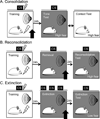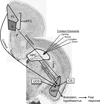Epigenetic mechanisms in fear conditioning: implications for treating post-traumatic stress disorder
- PMID: 25220045
- PMCID: PMC4258434
- DOI: 10.1016/j.tins.2014.08.005
Epigenetic mechanisms in fear conditioning: implications for treating post-traumatic stress disorder
Abstract
Post-traumatic stress disorder (PTSD) and other anxiety disorders stemming from dysregulated fear memory are problematic and costly. Understanding the molecular mechanisms that contribute to the formation and maintenance of these persistent fear associations is crucial to developing treatments for PTSD. Epigenetic mechanisms, which control gene expression to produce long-lasting changes in cellular function, may support the formation of fear memory underlying PTSD. We address here the role of epigenetic mechanisms in the formation, storage, updating, and extinction of fear memories. We also discuss methods of targeting these epigenetic mechanisms to reduce the initial formation of fear memory or to enhance its extinction. Epigenetic mechanisms may provide a novel target for pharmaceutical and other treatments to reduce aversive memory contributing to PTSD.
Keywords: PTSD; consolidation; epigenetics; extinction; fear conditioning; updating.
Copyright © 2014 Elsevier Ltd. All rights reserved.
Figures


Similar articles
-
Reconsolidation/destabilization, extinction and forgetting of fear memory as therapeutic targets for PTSD.Psychopharmacology (Berl). 2019 Jan;236(1):49-57. doi: 10.1007/s00213-018-5086-2. Epub 2018 Oct 29. Psychopharmacology (Berl). 2019. PMID: 30374892 Free PMC article. Review.
-
Reconsolidation and extinction: Using epigenetic signatures to challenge conventional wisdom.Neurobiol Learn Mem. 2017 Jul;142(Pt A):55-65. doi: 10.1016/j.nlm.2017.01.007. Epub 2017 Jan 21. Neurobiol Learn Mem. 2017. PMID: 28119018 Free PMC article. Review.
-
Influence of stress on fear memory processes in an aversive differential conditioning paradigm in humans.Psychoneuroendocrinology. 2013 Jul;38(7):1186-97. doi: 10.1016/j.psyneuen.2012.12.018. Epub 2013 Jan 18. Psychoneuroendocrinology. 2013. PMID: 23333200
-
How Fear Memory is Updated: From Reconsolidation to Extinction?Neurosci Bull. 2025 Jun;41(6):1054-1084. doi: 10.1007/s12264-025-01367-7. Epub 2025 Apr 9. Neurosci Bull. 2025. PMID: 40205305 Free PMC article. Review.
-
Epigenetics and memory: causes, consequences and treatments for post-traumatic stress disorder and addiction.Genes Brain Behav. 2015 Jan;14(1):73-84. doi: 10.1111/gbb.12187. Genes Brain Behav. 2015. PMID: 25560936 Free PMC article. Review.
Cited by
-
A narrative review of the epigenetics of post-traumatic stress disorder and post-traumatic stress disorder treatment.Front Psychiatry. 2022 Nov 7;13:857087. doi: 10.3389/fpsyt.2022.857087. eCollection 2022. Front Psychiatry. 2022. PMID: 36419982 Free PMC article. Review.
-
Epigenetic Mechanisms in Memory and Cognitive Decline Associated with Aging and Alzheimer's Disease.Int J Mol Sci. 2021 Nov 13;22(22):12280. doi: 10.3390/ijms222212280. Int J Mol Sci. 2021. PMID: 34830163 Free PMC article. Review.
-
Memory retrieval, reconsolidation, and extinction: Exploring the boundary conditions of post-conditioning cue exposure.Front Synaptic Neurosci. 2023 Mar 2;15:1146665. doi: 10.3389/fnsyn.2023.1146665. eCollection 2023. Front Synaptic Neurosci. 2023. PMID: 36937567 Free PMC article. Review.
-
Targeting acetyl-CoA metabolism attenuates the formation of fear memories through reduced activity-dependent histone acetylation.Proc Natl Acad Sci U S A. 2022 Aug 9;119(32):e2114758119. doi: 10.1073/pnas.2114758119. Epub 2022 Aug 3. Proc Natl Acad Sci U S A. 2022. PMID: 35921439 Free PMC article.
-
Exposure to war and conflict: The individual and inherited epigenetic effects on health, with a focus on post-traumatic stress disorder.Front Epidemiol. 2023 Feb 16;3:1066158. doi: 10.3389/fepid.2023.1066158. eCollection 2023. Front Epidemiol. 2023. PMID: 38455905 Free PMC article. Review.
References
-
- McGaugh JL. Memory--a century of consolidation. Science. 2000;287:248–251. - PubMed
-
- Greenberg PE, et al. The economic burden of anxiety disorders in the 1990s. J. Clin. Psychiatry. 1999;60:427–435. - PubMed
-
- Jarome TJ, Lubin FD. Histone lysine methylation: critical regulator of memory and behavior. Rev. Neurosci. 2013;24:375–387. - PubMed
Publication types
MeSH terms
Grants and funding
LinkOut - more resources
Full Text Sources
Other Literature Sources
Medical

